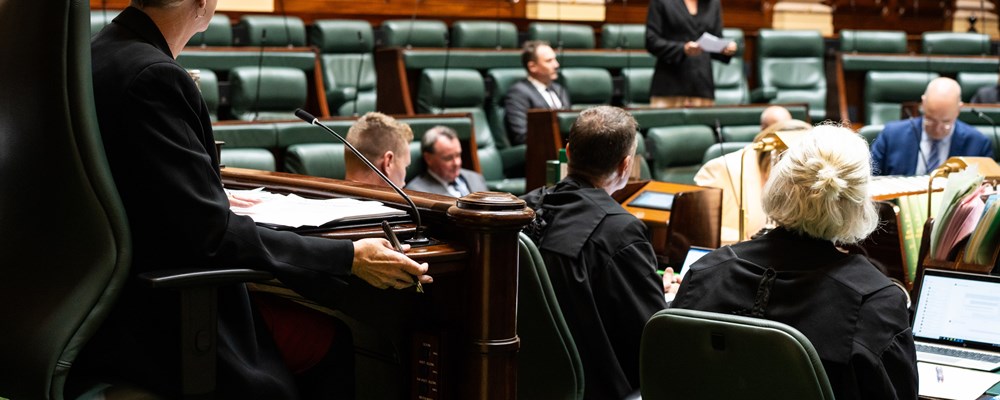How laws are made
One of Parliament’s key roles is to make laws. The process of passing a law has six steps.

On this page
1. An idea
Ideas for new or changed laws can come from anyone:
- members of Parliament
- political parties
- members of the public
- lobby groups
- parliamentary committees
- the media
- the public service and ministerial advisers.
If you have an idea for a new law, talk to your local member of Parliament.
2. Creating a bill
The idea is drafted in a document called a bill.
If the bill is brought by a government minister it is known as a government bill. If a bill is brought by a member other than a minister it is known as a private member’s bill.
The Office of the Chief Parliamentary Counsel drafts the wording for all bills.
3. Legislative Assembly
Most bills are debated by the Legislative Assembly first. The debate goes through several stages, known as readings.
-
Introduction and first reading
For government bills, the minister responsible will introduce the bill. For example, a bill about public transport will be introduced by the Minister for Public Transport.
If a bill is brought by a member who is not a minister, it will be introduced by that member.
Members vote on whether they will consider the bill.
The member responsible for the bill will also table (formally submit) a statement of compatibility. This explains whether the bill is consistent with the Victorian Charter of Human Rights and Responsibilities 2006. If not, the member must explain why. For example, a bill may be inconsistent with the right to freedom of movement if it would allow judges to give prison sentences.
-
Second reading
The minister (or member) who introduced the bill makes a speech explaining its purpose. This is called the second-reading speech.
After the second-reading speech, the bill is made public for the first time.
Debate on the bill is then adjourned (paused). This gives members time to read the bill, consult with their community and consider their response. This usually lasts two weeks.
When the bill is next debated, members can make speeches for or against the bill.
At the end of the debate, members vote on whether the bill should go to the next stage.
-
Consideration in detail
The bill is examined clause by clause. Members can ask questions of the minister (or member) responsible for the bill, and they vote on each clause of the bill. Members may propose amendments to the bill, and these are also voted on.
This stage may be skipped.
-
Third reading
Another vote is held as a last check to make sure a majority of members still approve of the bill.
4. Legislative Council
Once approved by the Assembly, the bill is sent to the Legislative Council.
-
Introduction and first reading
For government bills, the minister responsible will introduce the bill. For example, a bill about public transport will be introduced by the Minister for Public Transport.
If a bill is brought by a member who is not a minister, it will be introduced by that member.
Members vote on whether they will consider the bill.
The minister (or member) responsible for the bill will also table (formally submit) a statement of compatibility. This explains whether the bill is consistent with the Victorian Charter of Human Rights and Responsibilities Act 2006. If not, the minister (or member) must explain why. For example, a bill may be inconsistent with the right to freedom of movement if it would allow judges to give prison sentences.
-
Second reading
The minister (or member) who introduced the bill makes a speech explaining its purpose. This is called the second-reading speech.
Debate on the bill is adjourned (paused). This gives members time to read the bill, consult with their community and consider their response. This adjournment period is usually two weeks.
When the bill is next debated, members can make speeches for or against the bill.
At the end of the debate, members vote on whether the bill should go to the next stage.
-
Committee of the whole
The bill is examined clause by clause. Members can ask questions of the minister (or member) responsible for the bill, and they vote on each clause of the bill. Members may propose amendments to the bill, and these are also voted on.
This stage may be skipped.
If the Council passes the bill with amendments (changes), it will be sent back to the Assembly to be reconsidered.
-
Third reading
Another vote is held as a last check to make sure a majority of members still approve of the bill.
Some bills start in the Council. It does not usually matter where the bill starts, as long as both the Assembly and the Council go through all the reading stages.
The only exception is the yearly budget. Both houses debate the budget, but it only needs to be approved by the Assembly.
5. Royal assent
The bill is presented to the Governor of Victoria for royal assent.
Once royal assent is received, the bill becomes an Act of Parliament. This means it is a law of Victoria.
The Governor cannot refuse to give royal assent for political or personal reasons.
6. A new law
When the new law comes into force this is called ‘commencement’.
Some laws commence immediately after they have received royal assent.
Other laws do not commence until a date set out in the law or decided later by the Governor, with advice from ministers.


